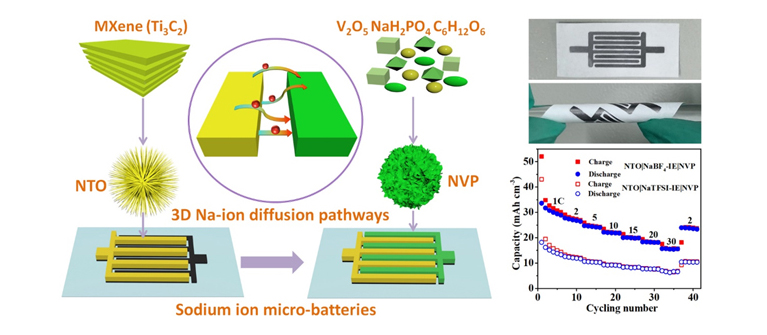A research team led by Prof. WU Zhongshuai and Prof. BAO Xinhe from Dalian Institute of Chemical Physics (DICP) of the Chinese Academy of Sciences, in collaboration with Prof. YU Yan from University of Science and Technology of China (USTC) recently developed high-performance ionogel-based sodium ion micro-batteries with 3D Na-ion diffusion mechanism, ultrahigh rate capability, high areal energy density, remarkable mechanical flexibility and high-temperature stability. The results were published in the journal Energy & Environmental Science.
High-performance, flexible and integrated micro-batteries with sufficient energy and form factors are urgently needed to satisfy the rapid and continuous development of microelectronics and microsystems, including wireless sensors, implantable medical devices, radio frequency identification, and portable or wearable electronics.
Planar lithium ion micro-batteries (LIMBs) with interdigital microelectrodes have been extensively investigated, which can be seamlessly integrated into microelectronic devices mounted on a planar integrated circuit, facilitating the miniaturization of the entire microelectronic system.
However, the development of LIMBs is limited by the scarcity, uneven distribution and increasing cost of metal lithium. Therefore, extensive efforts have been dedicated to the exploitation of sodium ion micro-batteries (NIMBs), because sodium is naturally abundant, low cost, and shows similarly low potential (-2.7 V vs SHE) as lithium.
However, reasonable construction of planar NIMBs with high performance and form factors is rarely reported due to the challenges of lacking of effective electron-ion diffusion network and suitable electrolyte.

Schematic diagram of sodium ion micro-batteries. (Image by ZHENG Shuanghao)
To address this issue, scientists from DICP and USTC report one prototype quasi-solid-state planar ionogel-based NIMBs constructed by separator-free interdigital
microelectrodes of sodium titanate anode and sodium vanadate phosphate cathode, both of which are embedded into three-dimensional interconnected graphene scaffold.
Meanwhile, a novel NaBF4-based ionogel electrolyte with robust ionic conductivity of 8.1 mS/cm was developed. The fabricated NIMBs revealed 3D multi-directional pathways for sodium ion diffusions, which can provide universal guidance to improve the performance of other planar micro-batteries.
Benefiting from the synergetic merits from the planar architecture, dominated pseudocapacitance contribution, and 3D multi-directional Na-ion diffusion mechanism, the as-assembled NIMBs exhibit high volumetric capacity of 30.7 mAh/cm3 at 1 C, and high rate performance with 15.7 mAh/cm3 at 30 C at room temperature and 13.5 mAh/cm3 at 100 C at high temperature of 100 oC.
Moreover, the quasi-solid-state NIMBs present outstanding flexibility, tunable voltage and capacity output, and remarkable areal energy density of 145 μWh/cm2 (55.6 mWh/cm3). Additionally, it is proposed that planar miniaturized energy storage devices are an ideal model to use in-situ characterization for the fundamental research on the charge storage mechanism.
This work was supported by National Natural Science Foundation of China, National Key R&D Program of China, Dalian National Laboratory for Clean Energy of CAS, etc. (Text by ZHENG Shuanghao, HOU Xiaocheng)